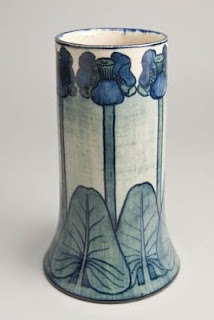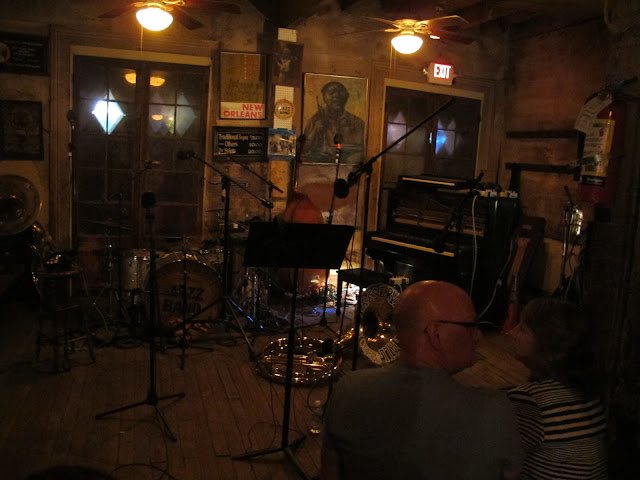 |
| New Orleans Sykline from the mighty Mississippi River |
 |
| This local saying became our motto. "In between" was cocktail time! |
We have been to New Orleans in the past, when we explored
some of the more traditional sights such as Gallier House, Hermann-Grima House, the Historic New OrleansCollection and the New Orleans Museum of Art as well as the plantation homes along the Mississippi, so we decided to do some different
things on this visit. It was a good idea to visit New Orleans in November over the week of Thanksgiving to warm up as the chilly gray
weather was descending on Philadelphia Canal Street
 |
Johnny's Po-Boy Restaurant Exterior |
After we unpacked, we set off to explore the French
Quarter. USAir doesn’t even offer
pretzels or nuts any longer, so we were really peckish, having had only a quick
early breakfast. Our first stop was at a
local place called Johnny’s Po-Boys. Dane had a fried fish muffaletta sandwich and
Joan had the classic oyster po-boy. We
enjoyed filling food and lots of local color.
 |
Muffaletta Sandwich (Yes, there's bread under all that seafood!) |
We strolled through Jackson Square, all decked out for the holidays, and paid an obligatory visit to St. Louis Cathedral then listened to an impromptu jazz concert on the street.
 |
| Jackson Square and St. Louis Cathedral in the French Quarter of New Orleans. |
After some café au lait from the
take-out window at Café Du Monde in the French Market, we walked up onto
the levee and enjoyed a late afternoon view of the mighty Mississippi
 |
The graceful entrance to the French Market in New Orleans |
Across Decatur
Street New Orleans
NOLA is not a place known for its fine craft
beers. This put Dane at a disadvantage,
so to console him, Joan set forth to introduce him to the world of cocktails –
something this city of Saints
 |
Pirate's Alley Cafe in New Orleans |
Having enjoyed two
traditional beverages of New Orleans, café au lait and exotic cocktails, we
continued by stopping at Pirate’s Alley Cafe, a small corner bar known for its
absinthe drinks. Joan loved the ceremony of
serving the “green fairy”. Our friendly pirate-hatted server put absinthe in a
small wine glass, and then put a small slotted silver tool which looked like a
tiny pie server on top of the glass to hold a cube of sugar. She put the glass
on a big coaster affair equipped with a green LED light, and then put it all
under the tap of a good sized ceremonial iced water urn. She turned on the
water in a slow drip onto the sugar cube then into the glass of absinthe. What a show!
One of the “Big Six” cocktails in New
Orleans
 |
Absinthe Frappe being made at Pirate's Alley in New Orleans
According to Fodor’s there are four hot chefs in NOLA—we
only got to two. We ate at Donald Link’s
flagship restaurant Herbsaint that evening. It was really impressive. Joan had a cassoulet and Dane had a Muscovy
duck, both excellent. They also offered
flights of three wines, Joan had the white and Dane the red flight. A memorable meal.
The glasses for our flights of wine at Herbsaint. |
The next day we did two walking tours of the French
Quarter. The first, with a National Park Service guide, had as its main focus the Mississippi
River .
The Park Service has
a very nice visitors’ center on Decatur
Street House Museum
Though our guide was a volunteer, she still
had to have a license requiring an extensive test. This was of interest to Dane, since he is a
proponent of licensed tour guides and is a certified tour guide in Philadelphia
 |
| Latrobe Park, honoring Benjamin Henry Latrobe, designer of New Orleans water system |
 |
| The faded grandeur of Napolean House; notice the bust over the cabinet |
 |
| A beautiful example of Newcomb Pottery |
We especialy enjoyed an exhibit by the Louisiana State Museum at Madame John's Legacy called The Palm, The Pine, and the Cypress about Newcomb Pottery of New Orleans. As collectors of Van Briggle and Woodcraft and Forest patterns of Weller art pottery, we loved looking at the fabulous pieces of Newcomb Pottery.
A property of the Louisiana
State Museum ,
Madame John's Legacy in the historic French Quarter is one of the finest 18th
century building complexes in Louisiana New Orleans
 |
| The 18th century Creole cottage known as Madame John's Legacy in New Orleans |
After some more wandering, we ended up at
Laffite’s Blacksmith Shop, a cottage built around 1730, perhaps the oldest building used as a bar in
America, and reputedly a front for the famous pirate Jean Laffite to peddle his
booty. It was also of the New Orleans
 |
| Joan enjoying a Hurricane cocktail at Lafitte's Blacksmith Shop |
That evening was special; we had reservations at the famous
Commander’s Palace.
Dane was expecting something very flashy and
touristy. Well, it was impressive, but
not at all touristy. On the way to our
table we were greeted by at least six staff members--as we walked by, they all
said “welcome.” To start, Joan had to
try the official cocktail of New Orleans, a Sazerac, made with rye whiskey, Peychaud's bitters and absinthe, while Dane enjoyed a traditional Manhattan
What a treat to not
have to ponder the menu. The staff,
especially our serving captain, was very friendly and convivial, and the food
was spectacular! The servers and the
captain were able to go into great detail about the menu items, and when we
remarked how impressed we were with the first course, a demitasse cup of honey
roasted parsnip soup, the captain even gave us the recipe, hand-written for us by
the chef.
Honey Roasted Parsnip Soup
12 parsnips
1
tablespoon chopped fresh thyme
3 onions, (medium
chop)
1 teaspoon
red chili flakes
2 quarts heavy cream
1/4
pound unsalted butter
3 tablespoons local
honey
salt and
white pepper to taste
Peel and chop the
parsnips, pan roast in butter over medium heat. Add chopped thyme and red chili flakes, and
then cook until parsnips begin to soften.
Add honey, stir well then roast whole pan in oven for 10 minutes at 375
degrees F.
Sweat onions in a
large pot with butter. Season the onions
with salt and white pepper. Add roasted
parsnips and all the pan drippings to the pot.
Stir well, add cream and let simmer for 20 minutes; the cream will
reduce by 20%. Puree, season et voila!
Luke Hidalgo, Sous
Chef,
Commander’s Palace
Restaurant, New Orleans
It was followed by Wild Burgundy Escargot Gnocchi; then a
palate cleanser called Saint 75 made of elderflower liquor, Bombay Sapphire
Gin, crushed citrus and basil syrup.
Next was the five hour egg (coddled for five hours at 141
)
followed by the main course
of smoked loin of Wild Texas
The next morning we decided to pass on breakfast at the
hotel and went to a local cafe called Mother’s Restaurant. Since 1938 this has been a place with
down-home food, best known for their baked ham and brisket. "Debris" on your biscuits or grits means slathered with meat shreds and juice. Debris is delicious!
During Hurricane Katrina the building took
water, but the real problem was that a lot of the staff became homeless. The owner arranged for FEMA trailers to be
set up in the parking lot for his staff, and they got the place back into shape
in a few weeks. Mother’s also has a Philadelphia Philadelphia Chestnut Street
After breakfast we walked down to the Mississippi Manhattan
After the museum, we hopped a shuttle to visit Kern’s Mardi Gras World. As is often the case, Dane was concerned
that this was going to be hokey. Well,
it was, but really interesting, much like the behind scenes tours at Disney
World, for whom the Kerns have done some work.
Most if not all of the major floats in the Mardi Gras parades are made
by the Kern’s workshops.
It was
interesting to see how they build the figures and floats, and it was a
photographer’s dream to plot out good shots of the assembled figures – after
the tour we were allowed to wander around their huge warehouse at will.
 |
| Some of the float decorations at Mardi Gras World in New Orleans |
A visit to a city wouldn’t be complete without a museum
visit, so we stopped at the Ogden Museum of Art, a small and very
manageable museum. We have a game we play
at museums--we walk into a room and try to decide which painting we would like
to stuff under our coats and take home.
Well, this time, Dane found a roomful he wanted by William Henry Stevens
1889-1949. (Wikipedia: an American modernist painter and naturalist. Stevens is known for his paintings and tonal pastels depicting the rural
Southern landscape, abstractions of nature, and non-objective works.) Of course now you all know what to get Dane
for his birthday. Alas, it was warm in New Orleans
From the Ogden
 |
| The meal started with a decadent amuse-bouche: a seafood and egg custard with a hint of truffle and topped with caviar served in a hollowed out egg shell. |
Of course the food and service were outstanding. The starter was an unusual egg concoction
that was served in an egg shell that had been perfectly topped. We asked how it was done, and our friendly
server went back to the kitchen to get the special little device to show
us. One unusual thing about this
restaurant was that they had a small but very nice beer list – Dane was happy,
not that he minded the cocktails.
Dane
ordered an excellent Belgian beer, and then simply asked the chef to choose an
entrée that would go well with it.
Next we were off to Preservation Hall for a jazz
concert. Our auction package included
“skip the line” tickets, and we were glad to have them as although we got there
early, the line was already to the end of the block. Preservation Hall doesn’t serve food or
beverages; there are just three 45 minute sets of jazz every night.
The place is New Orleans
Thursday, of course, was Thanksgiving. After breakfast at the hotel, we went back to
the French Quarter for a self-guided tour since we knew nothing much would be
open on the holiday. By this time we
knew our way around, but still enjoyed see some new neighborhoods. We had early dinner reservations, so we again
stopped by the Café du Monde
for a snack of café au lait and fresh beignets to tide us over. We were amused to see powdered sugar spills all over the sidewalks of New Orleans-apparently many people enjoy those puffy doughnuts all over town!
Then we hopped on a free
ferry for a 15 minute ride up the river to Gretna ,
just across the Mississippi Gretna
We did a little self-guided tour, then waited
for the return ferry on a bench on the levee; the highlight of the trip was
chatting with a colorful Cajun local who told us his life story.
We stopped at the Hotel Monteleone, the grande
dame of NOLA hotels for a bit of sustenance at the Carousel bar. The bar really does rotate, very slowly, and above is the top of a vintage carousel. Fun to look at but we were there for
something else.
Joan had a Ramos Gin
Fizz and Dane settled into what has become his favorite cocktail, a Vieux
Carre.
Vieux Carre Cocktail
½ oz. rye whisky
½ oz. cognac
½ oz. sweet red
Italian vermouth
Dash of Peychaud
bitters
Dash of Angostura
bitters
½ teaspoon Benedictine
Lemon twist
Mix all ingredients in
an ice-filled old fashioned glass, and garnish with lemon twist.
We had reservations for Thanksgiving dinner at
Tujaque’s,
one of the classic restaurants of New Orleans
You see, we had dined there our first night in New Orleans in 1984, and our daughter Elizabeth, like any one-year old, was a tad fussy. We recalled our server explained that the
owner’s wife was in back and loved children; he offered to let her mind our baby France New Orleans
The dining rooms, however, are very nice and
well cared for. This just goes to prove
that NOLA faded grandeur is really a desired objective – old and
authentic. It was a nice meal and a very
pleasant trip down memory lane for us.
Plus we enjoyed their traditional Thanksgiving menu with New Orleans
 |
| Shrimp Remoulade-a traditional New Orleans dish for an untraditional Thanksgiving starter at Tujaques. |
Our last day, we took a bus (alas, the famous St. Charles Avenue
In fact there are several such around NOLA. Dane did a little research and found out that
much of the cast iron came from Philadelphia Philadelphia 57 Canal Street New Orleans
 |
| An above-ground grave, called a mausoleum, in Lafayette Cemetery No. 1 |
Though there were more buildings to explore, and more
cocktails to savor, there was an airplane waiting for us, so we had to head
north, back home to Philadelphia, Dane’s beer drinking city.



















What a fun trip. The food looks fabulous and who doesn't love the authenticity of the city! Your terrific tour guides!
ReplyDeleteHey thanks, Mike! Next road trip I want to plan is around Lake Michigan, so watch out, we'll be in your neck of the woods!
DeleteJoan - this was a transportive read! We haven't been to NOLA in more than a decade so I am especially grateful (and salivating) for all the details.
ReplyDeleteHigh praise from someone whose writing I admire very much, Diane. Thanks for your kindness. The basic words are Dane's, the editing is Joan's!
ReplyDeleteSo enjoyed reading this!
ReplyDeleteGlad you enjoyed it, Ingrid!
DeleteThank you, Thank you, Thank you!
ReplyDeleteI had the Honey Roasted Parsnip Soup at CP last summer, and I haven't stopped thinking about it since. I couldn't find a decent recipe that came close to what they made. I am so grateful you not only got the recipe but posted it here!
I can't wait to try this at home--you made my day!
Roger
Glad you found the recipe, Roger! I made the recipe recently, and it was as delish as we remembered. Really, really rich. We just commented to our server team how much we enjoyed the recipe, and out came a handwritten recipe from the chef! Never hurts to ask!
Delete